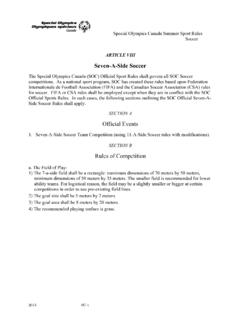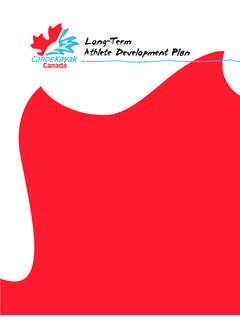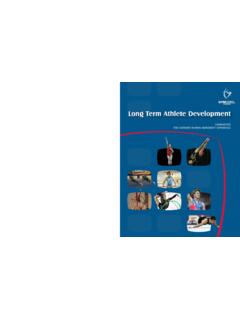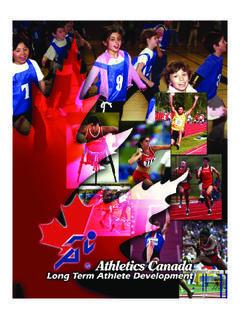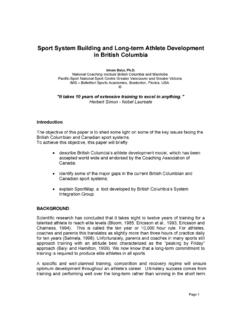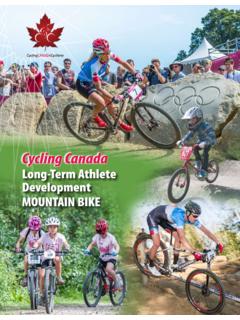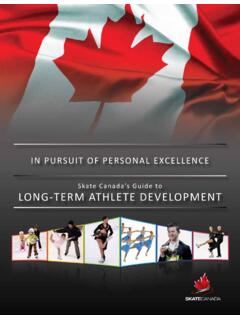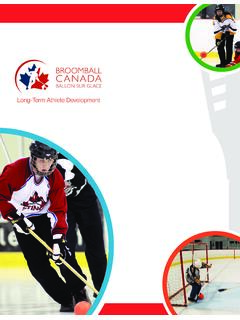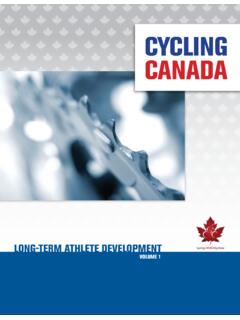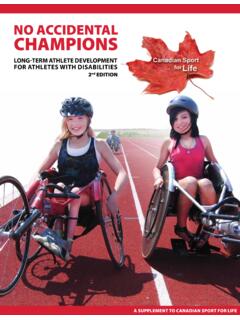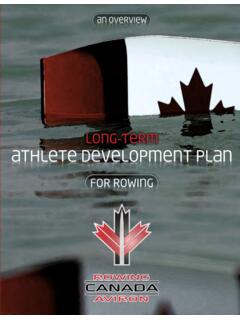Transcription of Long-Term Athlete Development - Special Olympics Canada
1 Long-Term Athlete Developmentfor athletes with an Intellectual DisabilityDecember 4, 2007 Executive Summary 3 About this Document 5 What is LTAD? 6 Maximizing Capacity 7 Mind the Gaps 8 Moving Forward: Addressing the Gaps 9An Introduction: Individuals with an Intellectual Disability and LTAD 1011 Key Factors of LTAD Key Factor #1: FUNdamentals 11 Key Factor #2: Early Specialization and Late Specialization 12 Key Factor #3: Biological Age 12 Key Factor #4: Trainability and Critical Periods of Development 13 Key Factor #5: Physical, Technical, Tactical, Psychological, and Lifestyle Developments 15 Key Factor #6: Training and Periodization 17 Key Factor #7.
2 Competition-Calendar Planning and Structure 17 Key Factor #8: System Alignment and Integration 19 Key Factor #9: Continuous Improvement 20 Key Factor #10: Assessment, Monitoring, Evaluation, and Guidance 21 Key Factor #11: The 10-Year Rule 21 The Long-Term Athlete Development Model for athletes with an Intellectual Disability 22 The Stages 23 Active Start 23 FUNdamentals 24 Learning to Train 25 Training to Train 27 Learning to Compete 28 Training to Compete 30 Training to Win 31 Active for Life 33 Conclusion 34 Framework for Guiding the Implementation Plan 35 Glossary 36 References 38 Appendix 1: An Overview of Sport-Related Research in the Area of Intellectual Disability 39 Appendix 2.
3 Acknowledgements 44 TABLE OF CONTENTSLong-Term Athlete Development Model Version 12 Special Olympics Canada3 Special Olympics Canada (SOC) has an opportunity to extend its tradition of quality programming by injecting new ideas stimulated by Sport Canada s Long-Term Athlete Development (LTAD) model. With the ultimate aim of promoting fitness, physical literacy, and well-being, the Athlete Development component of this model is driven by tenets of human growth and maturation and a complementary focus on strengthening interconnections among the many systems school, sport, and community that provide physical activity, sport, and competition avenues for all Canadians.
4 This is a transformative process that offers tremendous opportunities, especially for individuals with an intellectual disability. In embracing LTAD as the framework for guiding where SOC is going in the next 5 to 10 years, 3 overarching goals are being promoted:The recommendations throughout this document are based on the LTAD model and its application to sport and athletes with an intellectual disability. The SOC LTAD Working Group currently envisions 4 major areas that should be addressed as part of strategic planning and LTAD ) Introduce Special Olympics Programs in the Active Start and FUNdamentals Stagesn At the earliest opportunity, participants should enter a variety of programs that involve structured movement Participants need to be introduced to sport at an early age to build physical literacy and develop the sport skills they need to participate in early or late specialization sports.
5 2) Implement Competition Planning and Structuren SOC and its chapters should formalize a long -range Pan-Canadian competition calendar that provides competitive opportunities spanning local, regional, provincial, territorial, and national levels. This competition schedule could include options provided by other bodies such as provincial/territorial sport organizations (P/TSOs). The competition schedule must reflect athletes at the different stages of SUMMARYLet me win, But if I cannot win, Let me be brave in the attempt. Special Olympics Athlete s Oathn Individual fitness and well-being through programming that optimizes physical literacy by referencing instruction and competition according to growth and Development Equal respect for the interests of those who wish to participate in programs for fitness, fun.
6 And socializing and for those who are committed to pursuing personal excellence through more intensive sport training and A system of program and competition delivery that enables Special Olympics to preserve its unique character while fostering stronger linkages with the broader sport delivery system in Canada , thereby enhancing opportunities and increasing options for athletes and ensuring organizational Athlete Development Model Version 14n The present competition structure of Special Olympics should be reviewed in light of the different stages and principles of LTAD as well as the identified gaps (page 8).
7 N SOC must ensure that all athletes of all abilities are challenged to be the best that they can be using a fair and meaningful system of ) Establish Partnershipsn SOC coaches and administrators need to communicate with sport-specific organizations to see how athletes , coaches, and officials can benefit from various Development and competition opportunities to ensure good alignment with athletes developmental SOC must continue to coordinate and build relationships with national sport organizations (NSOs) to share knowledge and expertise regarding the sport-specific aspects of SOC should continue to improve all programs and increase the number of initiatives that address sport for life and sport excellence.
8 4) Develop Coach Educationn Program design for athletes must factor in mental, cognitive, and social/emotional maturity when developing training groups and determining which competitions the Athlete will attend. n Coaches need to understand the influence of the cognitive impairment as well as any associated or multiple disabilities when developing programs to train skill, stamina, strength, speed, and suppleness for individual Participants should be helped to select sports according to aptitude, interest, technical skill, and physical ability. A coach/caregiver may need to do remedial work in other areas to help participants get the most out of their sport Coaches should consult the sport-specific NSO for information on planning and Program leaders and coaches should use a variety of recognized testing protocols to help ensure the best possible fitness and sport preparation, be it to improve fitness and health or sport-specific performances in competition.
9 SOC may wish to assume a leadership role in integrating appropriate testing protocols into programs based on input from experts within the NSOs and from other related fitness and physical activity Because developing sport skills and sport-specific fitness and psychological attributes to compete effectively is a Long-Term process, programs should be structured Olympics Canada5 The purpose of the initial overview is ton describe LTAD and explain how the 11 key factors apply to individuals with an intellectual disability. n identify current issues in programming for participants whether they are pursuing lifelong physical fitness or more intensive levels of training for optimal competitive performance.
10 N systematically and coherently outline how each stage of LTAD might apply to individuals with an intellectual disability. n present a model that will address variations according to individual interests and will meet the needs of all individuals with an intellectual disability, addressing the importance of a sequential and coherent Athlete Development use the concepts presented in this document as a framework for evaluating existing programs, expanding partnerships with NSOs, and creating new across Canada are undergoing an LTAD review through which sport experts are examining existing aspects of their Athlete and program Development in relation to LTAD principles.
